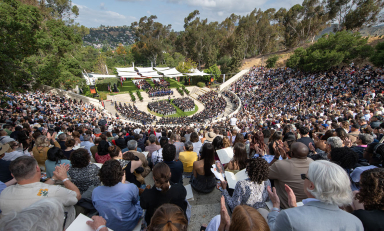Occidental College has begun work on a $6.8 million, 1-megawatt ground-mounted solar array, a project whose innovative design takes a distinctively liberal arts approach to green power with its blending of technology and art.
When completed in Spring 2012, it will be one of the largest ground-mounted arrays in the city of Los Angeles, generating approximately 11 percent of the College's annual electrical usage and an estimated savings of $200,000 a year. It also is believed to be one of the largest arrays in the country on a small college campus.
About 30 percent of the array's 4,886 panels will be mounted on top of shade structures installed in an existing campus parking lot. The remainder will be placed nearby on a southwest-facing hillside. With panels mounted just two to three feet above the ground, the hillside array will hug the topography of the slope in a curving design based on a mathematical expression known as a hysteresis loop (produced when an alternating magnetic field is applied to ferromagnetic material).
"While our chief goal has always been to reduce the College's dependence on fossil fuels, the more than two years we spent in developing the array reflects our desire to address solar power in a new, creative way," said Occidental President Jonathan Veitch. "It represents a new paradigm for arrays as architectural objects that, like buildings, are expected to contribute aesthetically to their environment."
Occidental's design for the array - created by Lettuce of Highland Park, in collaboration with college art faculty - will use highly efficient SunPower panels to limit its footprint. Martifer Solar of Los Angeles is the contractor.
Led by physics professor Daniel Snowden-Ifft, who proposed the idea, the lengthy process of bringing the project to fruition combined a creative approach to design with extensive community outreach to avoid the kind of controversy sparked by other ground-mounted arrays.
Occidental's array was endorsed by the Eagle Rock Neighborhood Council, The Eagle Rock Association, and Los Angeles City Councilmember Jose Huizar. In partnership with SunPower, Occidental is offering a discount on home solar installations to neighbors in the surrounding communities of Eagle Rock, Highland Park, and Mt. Washington.
The array also will function as an educational tool - for Occidental students, for students at local high schools, and the broader community. Occidental faculty have identified a dozen courses in several different departments that could incorporate the solar array into their syllabi. Oxy faculty also have met with their colleagues at nearby Franklin High School to discuss how it could be integrated into the high school science curriculum.
The array will remove 1,250 metric tons of carbon dioxide from the atmosphere every year - the equivalent of removing about 250 automobiles from the road. Electricity accounts for more than two-thirds of the College's utility costs, and 75% of its direct carbon consumption. A $3.4 million rebate from the Los Angeles Department of Water and Power will help finance the project.
Installation of the array is in keeping with the LADWP's goal of adding 130 megawatts of customer-owned solar power to the city's energy grid by 2020; Mayor Antonio Villaraigosa's goal of making Los Angeles one of the greenest cities in the country by that same date; and President Barack Obama '83's goal of increasing the use of renewable energy sources.



